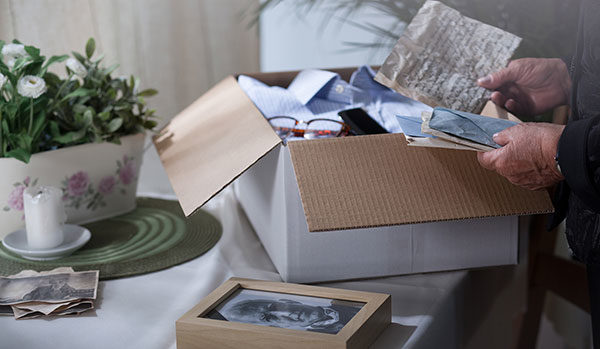Should It Stay or Should It Go? Making Peace with Our “Stuff”

The popularity of books such as “The Gentle Art of Swedish Death Cleaning” and programs like “Tidying Up with Marie Kondo” have many of us rethinking our possessions and living environments. The idea of organizing or downsizing (or “rightsizing,” as some like to call it) takes on new urgency as we approach retirement, face other major life changes, or decide to move to a smaller residence.
Read reviews of these books and programs and you’ll find that those who apply the steps generally come out the other end of the process feeling accomplished, more clear-minded, and happier; however, I have a warning to consider when undertaking such a large task—be prepared for the emotions that come with your possessions.
I’ve experienced it myself and watched as family, friends, and clients have gone through the process of deciding what to keep, what to donate, and what to throw away. The decisions are not made lightly. Often emotions are triggered by something as seemingly simple as a book, a knick-knack, a letter, an outdated piece of clothing, a photograph. You hold the item in your hands and suddenly the memories tied to that possession take over.
The heart of the Marie Kondo approach is to hold each item in your hands and ask yourself “Does it spark joy?” If it does, you keep it. If not, you get rid of it. But even if something doesn’t spark joy, it can still come with strong associations. Be prepared for this possibility. If you anticipate this ahead of diving into the project, you will be that much better prepared for this aspect of the process and better able to make thoughtful decisions.
Where do you begin? Many of us have lived in our homes for years. This makes the accumulation of things and memories more likely. There are many reasons we hold on to things, including sentimental attachments, perceived or real value, being overwhelmed, and feelings of self-worth and identity. Our clutter can also serve as a distraction from deeper issues we are avoiding and as a buffer from pain. So, you begin by acknowledging this reality and the associated emotions.
Acknowledge the emotions. Talk with a friend or loved one. If you find this difficult to do, seek the support of a counselor or therapist. It will promote healing and help you to move forward.
Approach it with an attitude of gratitude. Gratitude can be a powerful and positive emotion to apply throughout this process. If you look at your possessions through a lens of thankfulness, something shifts. Releasing items into the world becomes easier. Thanking an object for its purpose in your life might sound a little hokey but give it a try. You may find yourself better able to release the item as a result.
Enlist the help of others. I have a friend who lived in her 3,000+ square foot home for over 20 years. Widowed and an empty nester, she needed to move but was overwhelmed by the enormity of the task and the emotions that accompanied it. She was also overwhelmed by the maintenance of the house and living there alone. She got smart and enlisted the help of several friends who love her but didn’t share her emotional attachment to her belongings.
Valiantly, she made a sweep of her home and determined which items were non-negotiable by either moving the items to a spare room or marking them clearly with Post-It® notes (e.g., furniture). The rest was up to us. We were also responsible for taking these items with us. We could donate, keep, or give the items away. This gave my friend much less to deal with from the perspective of possessions, making the next round of downsizing and the job of moving much easier.
Storage—don’t! You’ll pack it and forget it. And you’ll pay a monthly fee for renting the storage space. Find a way to soldier through the rightsizing process. Now. Find new homes for the items that have served you well and can find a new life elsewhere:
- Take photographs of sentimental items and maintain a digital album. Several studies have shown that this helps keep the memories intact without the clutter of retaining the items.
- Find a nonprofit that redistributes items to those in need. They’d welcome your gently used clothing, bedding, furniture, kitchen gadgets, and electronics.
- Libraries appreciate book donations, as they can sell them and invest the proceeds in new equipment, books, and other resources. Some bookstores buy used books.
- Family heirlooms can become dust collectors. Is there someone else in your family who may cherish the item? Or a heritage group or museum that may welcome the item to their collection?
- For items in need of repair, ask yourself the following questions: Will you use that item if you fix it? Did you already replace it? What is the probability it can be repaired? Best to recycle or toss.
- Tools can be donated to a local tool exchange library, a scouting troop, or a technical school.
- For appliances in good repair, check with Habitat for Humanity ReStore. They also accept housewares, furniture, and building materials.
Hire a Senior Move Manager. This is a great option if you are moving to a smaller residence such as a senior living community. According to the National Association of Senior Move Managers, “Senior Move Management is the profession that assists older adults and their families with the emotional and physical aspects of relocation and/or ‘aging in place.’” Senior Move Managers are knowledgeable and experienced in coaching clients on how to winnow possessions and select what to take to a new residence, and can help find new homes for the items you chose not to keep.
We each have our own way of finding peace with our clutter. I hope that something I’ve shared has “sparked” a path forward to clear space, allowing room for new goals, your next chapter, and more adventure, without the burden of too much stuff.
 Contributor D’Anna Edison, MS, GMHS, LMHC, CMC, is a Certified Care Manager with Aging Wisdom and a Geriatric Mental Health Specialist with a Master of Science degree in Professional Counseling with an emphasis in Gerontology. She has worked with older adults and their families for over 20 years.
Contributor D’Anna Edison, MS, GMHS, LMHC, CMC, is a Certified Care Manager with Aging Wisdom and a Geriatric Mental Health Specialist with a Master of Science degree in Professional Counseling with an emphasis in Gerontology. She has worked with older adults and their families for over 20 years.
More Resources
- 1Green Planet (free recycling)
- Donate or Re-Sell (Seattle Public Utilities)
- Friends of The Seattle Public Library (donations)
- King County 2-1-1 (enter “donation” in Category Search)
- Music4Life (instrument donations)
- Repair Events (King County)
- Tool Lending Libraries (Local Tools)
![AgeWise King County [logo]](https://www.agewisekingcounty.org/wp-content/themes/agewisekingcounty/images/logo.png)